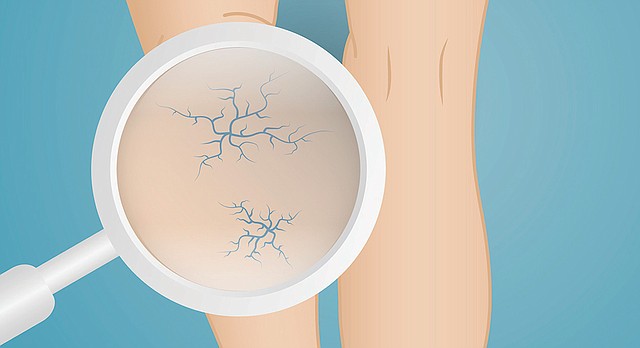Varicose veins: There’s much more at stake than mere vanity

Many treatment options are available for varicose veins, from the nonsurgical to the more invasive, depending on your circumstances.
By Amy Northrop | Lawrence Memorial Hospital
Tuesday, September 6, 2016
They might look like red and blue spider webs subtly tattooed on your legs and thighs. Or they may more resemble the gnarled branches of an old tree. Regardless, those varicose veins can often be more than just unsightly; they may cause pain, swelling and medical problems.
Varicose veins develop when the valves that allow blood to flow through the veins weaken, causing blood to stop or pool in the vein. As the blood collects, the veins dilate and enlarge, turning a bluish color because of the blood pooling and deoxygenation in that area.

Dale Denning, MD
Lawrence Vein Center
“The smaller, superficial veins, often called spider veins, are more visible because they’re closer to the skin’s surface,” said Dr. Dale Denning, medical director of the Lawrence Vein Center. “However, this is often just the ‘tip of the iceberg’ because larger, deeper veins are often feeding into these more superficial veins. It is important to treat these larger feeding veins in order to correct the problem.”
Denning has provided vein care since 2005. He is a diplomat of the American Board of Phlebology and a fellow of the American College of Surgery. He spent 20 years as a general surgeon at Lawrence Memorial Hospital.
He says that swelling or pain in the leg may also be the result of a blood clot, known as deep vein thrombosis. If this clot were to break free and travel to the heart or lungs, it could block blood flow causing a serious, medically urgent condition such as a pulmonary embolism, or even death.
There are a number of causes of varicose veins, which affect 30 to 40 percent of the population — men and women alike.
“Heredity is one of the main risk factors for developing varicose veins,” said Denning. “However, there are a number of lifestyle changes you can make that will lower your overall risk of developing vein disease too.”
Examples include:
● Maintain a healthy weight.
● Eat a well-balanced diet.
● Get regular exercise — walking, jogging, dancing, or bike riding — all activities that use the leg muscles.
● Don’t smoke.
● Avoid standing or sitting for long periods of time.
The Lawrence Vein Center is a full-service treatment center, dedicated exclusively to vein health. Cosmetic, nonsurgical, and minimally invasive vein treatment procedures, including sclerotherapy, VeinGogh, VenaCure EVLT™, and microphlebectomy, are available. These methods have a much shorter recovery period, less post-procedure pain, less bruising and swelling, and a lower overall risk of complications.
If you have pain, swelling or heaviness in your legs, especially to the extent that you feel your quality of life is compromised, schedule a consultation with the Lawrence Vein Center at 785-856-VEIN (8346). Or attend one of its free screening events this fall. (Free screenings are not available to Medicare and other federal health care beneficiaries.) Information is available at www.lmh.org/veincenter.
— Amy Northrop is physician liaison manager at Lawrence Memorial Hospital, a major sponsor of WellCommons. She can be reached at amy.northrop@lmh.org.